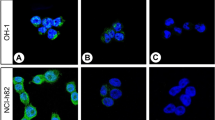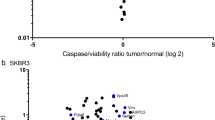Abstract
The purpose of this study was to investigate the histogenesis of Paget's cells of mammary and extramammary Paget's disease. Accordingly, rabbit antibodies to two glycoproteins, purified from human milk-fat-globule membrane and designated MFGM-gp 70 and MFGM-gp 155, were used to study the presence and patterns of distribution of these glycoproteins in formalin-fixed and paraffin-embedded tissue sections by an indirect immunoperoxidase staining method. Both antibodies recognized epitopes which are located on the protein domain of the molecules. MFGM-gp 70 as shown to be localized on the apical plasma membrane of luminal epithelial cells of all ducts and lobules of the mammary gland; it was also present in normal apocrine but not eccrine sweat glands coils and ducts in skin. MFGM-gp 155 was present on the apical plasma membrane of the cells of lobules and terminal ducts, but not larger ducts of mammary gland, normal apocrine and eccrine sweat glands coils and ducts, or sebaceous glands in skin. Neither of the antibodies reacted with keratinocytes or melanocytes. Under similar conditions, the antibodies to MFGM-gp 70 reacted with Paget's cells of 8 of 8 cases of mammary disease and 6 of 8 cases of extramammary disease. By contrast, MFGM-gp 155 was localized in Paget's cells of 7 of 8 cases of mammary disease but none of the 8 cases of extramammary disease. The underlying tumour cells of infiltrating ductal breast carcinoma, where one was present, consistently showed reactivity with antibodies to MFGM-gp 70 and MFGM-gp 155. These findings lend additional support to the postulates that (a) Paget's cells in the breast originate in most cases from neoplastic mammary epithelial cells and (b) mammary and extramammary Paget cells, although morphologically similar, differ in expressing MFGM-gp 155.
This is a preview of subscription content, access via your institution
Access options
Subscribe to this journal
Receive 24 print issues and online access
$259.00 per year
only $10.79 per issue
Buy this article
- Purchase on Springer Link
- Instant access to full article PDF
Prices may be subject to local taxes which are calculated during checkout
Similar content being viewed by others
Author information
Authors and Affiliations
Rights and permissions
About this article
Cite this article
Imam, A., Yoshida, S. & Taylor, C. Distinguishing tumour cells of mammary from extramammary Paget's disease using antibodies to two different glycoproteins from human milk-fat-globule membrane. Br J Cancer 58, 373–378 (1988). https://doi.org/10.1038/bjc.1988.222
Issue Date:
DOI: https://doi.org/10.1038/bjc.1988.222
This article is cited by
-
MiR-155, a potential serum marker of extramammary Paget’s disease
BMC Cancer (2018)



